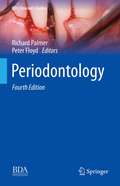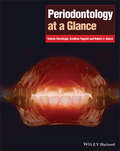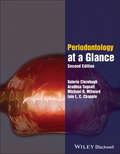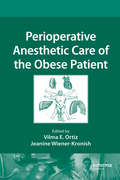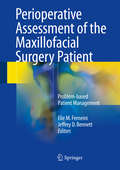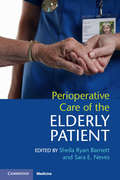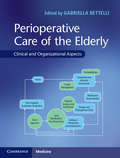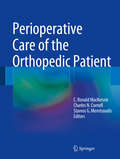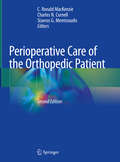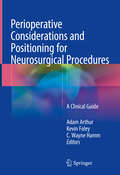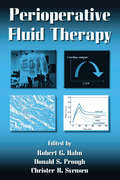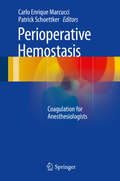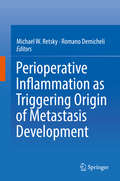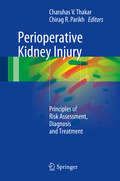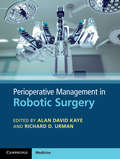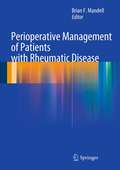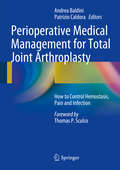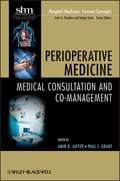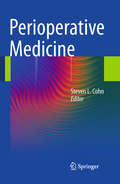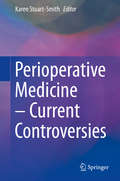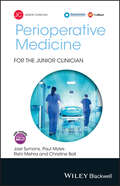- Table View
- List View
Periodontology (BDJ Clinician’s Guides)
by Richard Palmer Peter FloydThis book guides through all essentials in the field of periodontology including the pathology, diagnosis, and treatment of the most common periodontal conditions. Now in its 4th edition, this fully updated version marks the 25th anniversary of the first edition. It discusses the developments in classification while maintaining a no-nonsense logical approach to what many people find a complex subject. The book will help clinicians acquire and maintain the knowledge and skill to treat the many patients encountered in day-to-day practice. It covers the scientific background of periodontal-systemic disease interactions, the clinical application of periodontal surgery and the management of multi-rooted teeth. With newly incorporated supplementary information, the book will be a helpful source for general dentist, dental students, dental hygienists and even for postgraduate students.
Periodontology at a Glance
by Valerie Clerehugh Aradhna Tugnait Robert J. GencoPeriodontology at a Glance is designed as a study aid and revision guide for students of dentistry and dental hygiene. It also provides a useful recap for clinicians. The coverage includes aetiology, microbiology, development, and progression of the periodontal diseases. It tackles issues of diagnosis and treatment planning through to practical, hands-on periodontics.
Periodontology at a Glance (At a Glance (Dentistry))
by Valerie Clerehugh Aradhna Tugnait Michael R. Milward Iain L. ChapplePeriodontology at a Glance The market‐leading at a Glance series is popular among healthcare students and newly qualified practitioners, for its concise and simple approach and excellent illustrations. Each bite‐sized chapter is covered in a double‐page spread with clear, easy‐to‐follow diagrams, supported by succinct explanatory text. Covering a wide range of topics, books in the at a Glance series are ideal as introductory texts for teaching, learning and revision, and are useful throughout university and beyond. Everything you need to know about Periodontology… at a Glance! Brief but comprehensive overview of periodontology from the At a Glance series Periodontology at a Glance, Second Edition provides readers with key information on periodontology in an easy-to-use reference. Following the At a Glance series style, this revised and expanded edition illustrates each topic with a double page spread/short chapter that encapsulates the essential knowledge. Clear diagrams and clinical pictures are included throughout and accompanied by succinct text, providing a highly visual format to facilitate ease of learning. This second edition is divided into 6 uniquely colour-coded parts, designed to guide the reader through the various topics in a visually appealing manner. The authors have distilled the salient research literature and evidence base, and made suggestions for further reading where appropriate. Sample topics covered in Periodontology at a Glance include: Anatomy of the periodontium, classification of periodontal diseases, periodontal epidemiology, role of plaque in the aetiology of periodontal diseases, and plaque biofilm microbiology. Host defenses, development and progression of periodontal diseases, systemic risk factors for periodontal diseases, periodontal diseases and general health. Diet and periodontal diseases, local risk factors for periodontal diseases, periodontal history, examination and diagnosis, and periodontal screening. Principles of periodontal diagnosis and treatment planning, plaque control, non-surgical periodontal therapy, and periodontal tissue responses, healing, and monitoring. Periodontal surgery, dental implants and peri-implant mucositis/peri-implantitis. Periodontal health; plaque biofilm-induced gingivitis, non-plaque-induced gingival conditions, gingival recession, gingival enlargement, periodontitis and its staging and grading, periodontal management of patients who smoke/have diabetes, necrotising periodontal diseases, periodontal abscesses, endodontic-periodontal lesions, periodontal diseases in younger and older patients, and the delivery of periodontal care. Providing comprehensive coverage of the subject, the Second Edition of Periodontology at a Glance is an essential resource for dental undergraduates and hygiene therapy students, and also serves as a helpful refresher for qualified dentists preparing for a general examination or looking for a relatively quick update in the field.
Perioperative Addiction
by Ethan O. Bryson Elizabeth A. FrostPerioperative Addiction addresses an issue that every anesthesiologist will encounter many times during the course of his or her career: the patient who arrives for operative care under the influence of legal or illegal drugs. The editors and contributors provide expert guidance on how to identify and manage the addicted patient, approaching the subject from the vantage points of the specific drug and of special patient populations. Features: · Guidance for spotting and managing addicted patients · All common and important drugs of addiction, from opioids, cocaine, club drugs, and alcohol, to tobacco, marijuana, nitrous oxide, inhalants, and propofol · Special populations, including pregnant women, pain patients, adolescents, older patients, and healthcare professionals · Fascinating overview of the long history of addiction · Genetic basis of addiction, and the range of pharmacological treatments for addiction
Perioperative Anesthetic Care of the Obese Patient
by Vilma E. Ortiz Jeanine Wiener-KronishThe only available resource to provide cutting-edge, in-depth coverage of the links between obesity and anesthesia in surgery, the reader-friendly Handbook of Perioperative Anesthesia: Complications and Challenges of the Obese Patient guides the practicing anesthesiologist through each stage of surgery for the obese patient. This clinically relevan
Perioperative Assessment of the Maxillofacial Surgery Patient: Problem-based Patient Management
by Elie M. Ferneini Jeffrey D. BennettThis book is designed to guide the practitioner in the medical and anesthetic management of the maxillofacial surgery patient, serving as a comprehensive, up-to-date resource that will assist in patient work-up and response to any medical problem. It is divided into four sections that provide an overview of general and basic topics relevant to perioperative assessment, explain the assessment and management of diverse medical issues and co-morbidities, discuss the perioperative, pharmacological, and supportive management of maxillofacial treatment, and identify potential complications and their management. All of the authors have been carefully selected for their expertise in the topics that they discuss. While the book will be especially valuable for oral and maxillofacial surgeons, it will also be highly relevant for multiple other health care providers, including dentists, dental specialists, dental hygienists, otolaryngologists, plastic and reconstructive surgeons, medical residents, nurses, and physician assistants.
Perioperative Care of the Elderly Patient
by Sheila Ryan Barnett Sara E. NevesOlder patients carry some of the highest risks of suffering an adverse event or death following anesthesia and surgery. They are inherently vulnerable, presenting with numerous comorbidities and reduced physiological reserve, requiring 'gero-centric' perioperative care for everything from routine eye surgery to major cardiac surgeries. Dementia, frailty, and the need for palliative care and pain management for the orthopedic patient are important areas requiring special consideration in this group. This book provides a general overview of these topics for those healthcare providers who may not have extensive knowledge of this patient population, while at the same time offering practical tips for the more experienced clinician. Chapters cover the spectrum of perioperative care including preoperative management of comorbid conditions, intraoperative anesthetic management, postoperative pain control, and a primer on advanced directive discussions. This book is appropriate not only for anesthesiologists but for any perioperative physician caring for the older patient.
Perioperative Care of the Elderly: Clinical and Organizational Aspects
by Gabriella BettelliThis innovative, comprehensive book covers the key elements of perioperative management of older patients. The book's chapter structure coincides with the clinical path patients tread during their treatment, from preoperative evaluation to post-hospital care. Epidemiological aspects and aging processes are illustrated, providing keys to understanding the quick expansion of geriatric surgery and defining the clinical profile of older surgical patients in a cybernetic perspective. Preoperative evaluation and preparation for surgery, including medication reconciliation and pre-habilitation, are developed in the light of supporting decision-making about surgery in an evidence-based and patient-focused way. Intra- and postoperative management are discussed, aiming to tailor anesthetic, surgical and nursing approaches to specific patients' needs, in order to prevent both general and age-related complications. This volume also addresses issues relevant to geriatric surgery, from different organizational models to clinical risk management and systems engineering applied to hospital organization.
Perioperative Care of the Orthopedic Patient
by C. Ronald Mackenzie Charles N. Cornell Stavros G. MemtsoudisWritten by experts at the top-ranked Hospital for Special Surgery in New York, Perioperative Care of the Orthopedic Patient is a comprehensive, multidisciplinary manual providing preoperative considerations, postoperative complications, and guidelines for the anesthetic and medical management of patients undergoing orthopedic surgery. Beginning with chapters covering preoperative evaluations and general principles and practices of perioperative medicine, the book then considers anesthesiologic management in orthopedic surgery and the role of postoperative pain management. This is followed by a section on medical management in specific clinical settings, discussing patients with connective tissue disease, cardiac disease, chronic pulmonary and renal diseases, diabetes and psychiatric and neurological diseases. A fourth section covers specific perioperative problems in orthopedic surgery, such as care of the elderly patient, venous thromboembolism, infection, nutrition, compartment syndrome, and bone health. Finally, the role of allied services, quality improvement and ethics are highlighted, and selected case studies are included to illustrate real-world perioperative issues and management strategies in orthopedic surgery. A comprehensive yet concise reference, Perioperative Care of the Orthopedic Patient will be an invaluable resource for orthopedic surgeons, sports medicine specialists and any professional involved in orthopedic surgery.
Perioperative Care of the Orthopedic Patient: The Hospital For Special Surgery Manual
by Charles N. Cornell Stavros G. Memtsoudis C. Ronald MacKenzieAlthough a number of comprehensive texts pertaining to perioperative medicine are available, this remains the only one that focuses specifically on the patient undergoing orthopedic surgery, now in a revised and expanded second edition. Beginning with chapters covering preoperative evaluations and general principles and practices of perioperative medicine, the book then considers anesthesiologic management in orthopedic surgery and the role of postoperative pain management. This is followed by a section on medical management in specific clinical settings, discussing patients with connective tissue disease, cardiac disease, chronic pulmonary and renal diseases, diabetes and neurological diseases, among others. A fourth section covers specific perioperative problems in orthopedic surgery, such as care of the elderly patient, venous thromboembolism, infection, nutrition, compartment syndrome and bone health. Finally, the role of allied services, quality improvement and ethics are highlighted. Selected case studies are included to illustrate real-world perioperative issues and management strategies in orthopedic surgery, now moved to their respective chapters for ease of use and reference. The shaded key points and chapter objectives boxes at the beginning of each chapter, and the summary points at the end of each chapter, have been retained and updated within a full-color interior.Written by experts at the top-ranked Hospital for Special Surgery in New York, Perioperative Care of the Orthopedic Patient, 2e will be a comprehensive, multidisciplinary manual providing preoperative considerations, postoperative complications, and guidelines for the anesthetic and medical management of patients undergoing orthopedic surgery. It will be an valuable resource for orthopedic surgeons, sports medicine specialists and allied professionals involved in orthopedic surgery.
Perioperative Considerations and Positioning for Neurosurgical Procedures: A Clinical Guide
by Adam Arthur Kevin Foley C. Wayne HammThere are relationships that exist between neuroanesthesia, neurosurgical procedures, individual patient pathology and the positioning of a patient for said procedure. A comprehensive examination of these relationships, their association with patient morbidity/mortality and how to approach these issues in an evidence-based manner has yet to become available. Positioning related injuries have been documented as major contributors to neurosurgical/neuroanesthesiology liability.This text examines these relationships. It provides considerations necessary to the correct positioning of a patient for a neurosurgical procedure for each individual patient and their individual pathology. In other words, this text will demonstrate how to construct the necessary surgical posture for the indicated neurosurgical procedure given the individual constraints of the patient within the environment of anesthesia and conforming to existing evidence-based practice guidelines. Sections will address physiological changes inherent in positioning in relation to anesthesia for neurosurgical procedures, assessment of patient for planned procedure, as well as considerations for managing problems associated with these relationships. Additional sections will examine the relationship between neurosurgical positioning and medical malpractice and the biomechanical science between positioning devices and neurosurgical procedures.Neurosurgery and its patient population are in a constant state of change. Providing the necessary considerations for the neurosurgical procedure planned under the anesthesia conditions planned in the position planned, often in the absence of multicase study literary support, without incurring additional morbidity is the goal of this text.
Perioperative Drill-Based Crisis Management
by Steven ButzIt is essential that medical professionals in the operating room regularly undertake emergency drills. This unique book takes what can be an onerous task for leaders and operating room physicians, and makes it easy. Chapters cover drills ranging from medical emergencies such as cardiac arrest and malignant hyperthermia, to non-medical emergencies such as an active shooter and evacuation of a medical facility. Each chapter includes at least three scenarios for a specific type of drill, with expected actions and educational material for debriefing. The latest specialty guidelines and algorithms are included throughout and key learning points are highlighted for each drill, removing the need for further detailed research in advance of each exercise. Written and edited by leading experts in the field and endorsed by the Society for Ambulatory Anesthesia, this manual enables every reader to lead a meaningful drill with educational value for all participants.
Perioperative Fluid Management
by Ehab Farag Andrea Kurz Christopher TroianosThis revised and expanded second edition presents the most recent evidence-based facts on perioperative fluid management and discusses fluid management from basic sciences to clinical applications and the patients’ outcomes.Recent advances in understanding the Revised Starling principle with new concepts in tissue perfusion and the most recent techniques of perioperative goal directed fluid management are described. The endothelial glycocalyx functions and the influence of fluid management on its integrity are covered in detail; moreover, the techniques for its protection are also discussed. The dilemma of perioperative use of hydroxyethyl starch solutions and the resurgence of interest in using human albumin as an alternative colloid is explored. The problems of using unbuffered solutions during the perioperative period and comparison between restrictive versus liberal fluid management are discussed in full. Lastly, case scenarios for every possible clinical situation describe the most up-to-date fluid management for the corresponding clinical problem. Perioperative Fluid Management, Second Edition is of interest to anesthesiologists and also intensivists.
Perioperative Fluid Therapy
by Robert G. Hahn Donald S. Prou Christer H. StensenPerioperative fluid therapy requires the correct selection, amount, and composition of fluids based on the patient's underlying pathology, state of hydration, and type and duration of surgical stress. Filling a gap in the literature, this source provides a solid foundation to practical perioperative fluid management, fluid solutions, and the utiliz
Perioperative Hemodynamic Monitoring and Goal Directed Therapy: From Theory to Practice
by Maxime Cannesson Rupert PearseThis unique book provides clinicians and administrators with a comprehensive understanding of perioperative hemodynamic monitoring and goal directed therapy, emphasizing practical guidance for implementation at the bedside. Successful hemodynamic monitoring and goal directed therapy require a wide range of skills. This book will enable readers to: • Detail the rationale for using perioperative hemodynamic monitoring systems and for applying goal directed therapy protocols at the bedside • Understand the physiological concepts underlying perioperative goal directed therapy for hemodynamic management • Evaluate hemodynamic monitoring systems in clinical practice • Learn about new techniques for achieving goal directed therapy • Apply goal directed therapy protocols in the perioperative environment (including emergency departments, operating rooms and intensive care units) • Demonstrate clinical utility of GDT and hemodynamic optimization using case presentations. Illustrated with diagrams and case examples, this is an important resource for anesthesiologists, emergency physicians, intensivists and pneumonologists as well as nurses and administrative officers.
Perioperative Hemostasis
by Carlo Enrique Marcucci Patrick SchoettkerAll anesthesiologists are confronted with patients who show bleeding disorders, whether congenital, acquired, or pharmacologically induced. Although many studies, meta-analyses, guidelines, and textbooks have been published on the subject, they mostly cover specific aspects or require a thorough knowledge of hemostasis. The goal of this book is to provide the anesthesiologist with an overview of hemostasis and the mechanisms underlying bleeding and coagulation in general and to assist in the understanding of specific coagulation disorders as they may occur in the various anesthesia subspecialties. It is hoped that, through the provision of practical information and tools, the book will help residents and trained anesthesiologists to manage one of the most frustrating challenges that they face: the bleeding patient. A full understanding of coagulation requires a lifelong career, and this book is not intended to replace the consulting hematologist, whose expert opinion should always be sought. The available procoagulant blood products and drugs all have potentially dangerous side-effects; furthermore, in bleeding disorders pitfalls are frequent and a misdiagnosis can have potentially catastrophic consequences. The aim of the editors is thus instead to enhance the collaboration between the disciplines of Anesthesiology and Hematology.
Perioperative Inflammation as Triggering Origin of Metastasis Development
by Michael W. Retsky Romano DemicheliThe book will explain previously unconnected clinical data such as why mammography works better for women age 50-59 than it does for women age 40-49, why adjuvant chemotherapy works best for premenopausal patients with positive lymph nodes, and it may also explain the racial disparity in outcome. In particular, it points to the perioperative period when systemic inflammation persists for a week or so. This can lead to a variety of mechanisms whereby single cancer cells (perhaps from the marrow) begin division and angiogenesis of dormant avascular micrometastases occurs leading to early relapses. With chapters presented from distinguished scientists and physicians in a variety of specialties that relate to and border the effects we present, this volume can be used as a reference for practicing physicians and as a jumping-off point for researchers to explore new therapeutic opportunities.
Perioperative Kidney Injury
by Charuhas V. Thakar Chirag R. ParikhThe kidneys participate in all vital processes of the body to maintain overall homeostasis and health. When kidneys are injured during surgical interventions, metabolic and hemodynamic control is disrupted, leading to dysfunction associated with greater mortality, length of hospital stay and cost. Peri-operative Kidney Injury presents the epidemiology, risk factors, diagnosis, treatment and outcomes associated with kidney injury during the peri-operative period. Concepts and principles of care to prevent kidney complications during surgical procedures are provided to equip health care professionals along with strategies to manage acute kidney injury and associated challenges when they occur. Chapters detail diverse surgical settings, ranging from the more common, such as abdominal, cardiac and vascular surgeries, to the intricately complex, including the use of the left ventricular assist device and organ transplants. This practical and comprehensive text blends the evidence-based standards of care with cutting edge advances in the field, while also providing the reader with a peek into innovations on the horizon.
Perioperative Management in Robotic Surgery
by Kaye Daba Dabpm Dabipp Alan David Urman Richard D. CpePerioperative Management in Robotic Surgery covers perioperative considerations for robot-assisted surgery (RAS), from preoperative through to postoperative. This is the first extensive, evidence-based, clinical work covering the perioperative management of commonly performed and emerging RAS. Included inside are discussions of surgical procedures, preoperative evaluation, patient selection, common emergencies, complications, pain management and recovery (including same day surgery). There are also reviews of patient management, the basics of various procedures and techniques, useful patient care protocols, as well as an overview of the perioperative issues that are unique to any given RAS procedure. Written for anesthesiologists, surgeons, and other perioperative physicians - as well as allied health professionals, nurses, and physician assistants who assist during RAS procedures and help manage patients during the perioperative period.
Perioperative Management of Patients with Rheumatic Disease
by Brian F. MandellPerioperative care of the patient with a multisystem inflammatory (rheumatic) disease has become increasingly complex and perioperative medicine has evolved into its own subspecialty. Physicians who have expertise in managing patients with rheumatic disease infrequently spend significant time also managing patients undergoing surgical procedures, and the reverse is equally true. Despite the burgeoning literature on the medical management of the surgical patient, scant data have been generated regarding patients with complex rheumatic disease. Perioperative Management of Patients with Rheumatic Disease fills a conspicuous gap in the literature and aims at providing a paved path for rheumatologists--who infrequently manage surgical problems--and medical consultants--who only seldom encounter patients with rheumatic diseases--to tread as they care for patients in the perioperative period. The book addresses discrete management issues from the perspective of the medical subspecialist and also offers concise descriptions of surgical procedures. Written from the surgical perspective for the internist, the surgical procedure chapters include a brief description of relative contraindications, time to recovery, rehabilitation suggestions, and comments regarding common and severe procedure specific postoperative complications.
Perioperative Medical Management for Total Joint Arthroplasty
by Andrea Baldini Patrizio CaldoraThis volume describes the most recent medical guidelines for perioperative management in arthroplasty with the aim of facilitating excellent control of bleeding/thrombosis, pain and infection. For each area - hemostasis control, pain control and infection control - hot topics of key practical importance are discussed and contrasting perspectives are presented on controversial issues, covering the views of different practitioners and specialties. Using the information contained in this book, the practitioner will be in an excellent position to meet the principal goals of perioperative medical management. The information provided will assist in the choice of a multimodal guideline that minimizes the complication rate regarding bleeding and thromboembolism while not interfering with the patient's recovery. Similarly, effective means of pain control and an optimized pain control protocol are discussed with a view to shortening hospital stay and achieving functional milestones that meet the patient's expectations. Finally, host, wound and environmental factors relevant to infection and its prevention are explained, with discussion of the best means of prophylaxis, treatment and imaging. Surgeons, anesthesiologists and all medical practitioners and staff involved in the field of total hip and knee arthroplasty will find this book to be of value in their daily clinical practice. It will assist in the provision of enhanced medical management that ensures quicker recovery of the patient with fewer complications.
Perioperative Medicine
by Amir K. Jaffer Paul GrantProvides a comprehensive evidence-based guide to the management of the growing population of patients who require perioperative carePerioperative Medicine: Medical Consultation and Co-Management is the first comprehensive reference text developed specifically for hospitalists but envisioned also to help internists, anesthesiologists, allied health professionals, fellows, residents, and medical students manage various aspects of the medical care of the surgical patient. The book features both the preoperative and postoperative medical management of the surgical patient. It focuses on systems, operations, quality of perioperative care, and preoperative assessment of the patient, all in consideration with system-specific risk and evidence-based strategies that minimize risk. It places special emphasis on care of the older hospitalized surgical patient and offers a thorough discussion of post-operative conditions and their management.Chapters cover vital topics such as:Hospitalist as a Medical ConsultantCo-Management of the Surgical PatientPreoperative EvaluationImproving the Quality and Outcomes of Perioperative CareDeveloping, Implementing, and Operating a Preoperative ClinicAssessing and Managing Risk of Major Organ SystemsAssessing and Managing Disorders for SurgeryPostoperative Care and Co-Management by Surgery TypeManaging Common Postoperative ConditionsWith the core responsibilities of perioperative care falling more and more on the shoulders of hospitalists, internists, and allied health professionals, Perioperative Medicine is a much-needed guide for managing the clinical and operational issues associated with caring for hospitalized surgical patients.
Perioperative Medicine
by Steven L. CohnPerioperative Medicine uses a concise, highly practical, bulleted format designed to ensure rapid comprehension of key concepts and reinforce the reader's understanding of complex topics in perioperative medicine. It contains authoritative, up-to-date coverage of the most essential concepts in perioperative care from preoperative risk assessment to postoperative follow-up. The Editor and his contributors use their expert insight and experience to provide an in-depth review of comorbid conditions, patient and surgery-specific risk assessment, and common postoperative complications. This new book reviews recent developments in the field, including published guidelines, and emphasizes an evidence-based, cost-effective approach designed to ensure quality, patient safety, and optimal outcomes. It is intended for use by hospitalists, general internists and subspecialists as well as anesthesiologists, surgeons, and residents in training who are caring for patients before and after surgery.
Perioperative Medicine - Current Controversies
by Karen Stuart-SmithThis book addresses those aspects of anaestheticpractice in perioperative medicine which have a significant impact on both theimmediate and the long-term outcome for the surgical patient. PerioperativeMedicine is the natural evolution of anaesthesia from a main focus on thepatient in the operating room to a responsibility for the care of the patientfrom the time that the decision to operate is made, through to discharge fromhospital. The contributors, well-respected authors in their field, discuss therole of the perioperative medicine specialist in areas ranging frompre-operative assessment and physiological optimization via pre-habilitation,to intra-operative anaesthetic management, and post-operative care. Controversial topics discussed include fluid therapy, anaesthesia and canceroutcomes, pharmacological management of cardiac risk, and the evolution ofacute to chronic pain. Developments in regional anaesthesia, quality ofrecovery scoring, and lung ultrasound, are described. It is hoped that the chapters contained in this bookwill help to define the nascent specialty that is Perioperative Medicine, andencourage further debate, research, and expansion of this vital new frontier inanaesthetic care.
Perioperative Medicine for the Junior Clinician
by Paul Myles Christine Ball Rishi Mehra Joel SymonsPerioperative Medicine for the Junior Clinician is the first easy-to-read resource, featuring a digital component, on how to manage a diverse range of patients in the perioperative period, providing up-to-date practical knowledge and advice from a broad range of medical specialists caring for surgical patients. Perioperative Medicine for the Junior Clinician provides a guide to perioperative care, covering principles and practices of care; risk assessment; laboratory investigations; medication management; specific medical conditions and complications; postoperative care and pain management. It also features bite-size videos explaining the key concepts, as well as case studies, investigations and quizzes. Ideal for final year medical students and junior clinicians, this digital and print resource will be an invaluable tool when working in this multidisciplinary, team-based specialty. Perioperative Medicine for the Junior Clinician: Is based on a sell-out course run at the Alfred Hospital and Monash University in Melbourne, Australia Is a practical resource available in a flexible and portable content Features bite-size videos which further explain concepts in the written text, and clinically relevant case studies, all found on the companion website Is structured around guidelines and protocols The video materials, case studies, self-assessment quizzes and fully explained answers can be viewed on the companion website at www. wiley. com/go/perioperativemed
